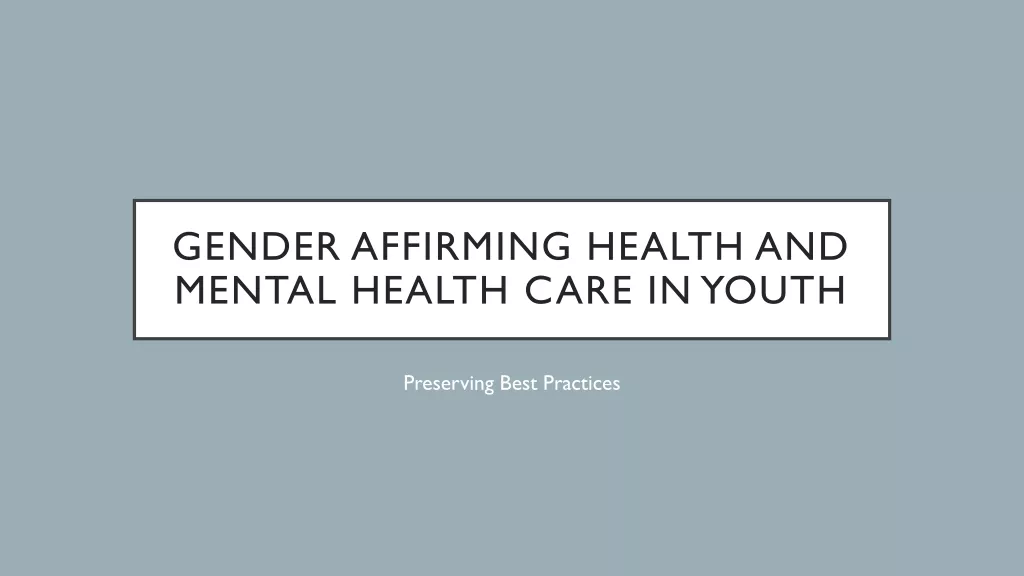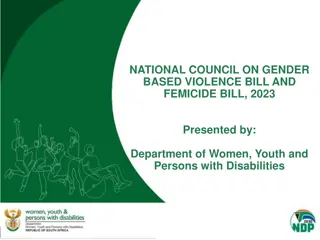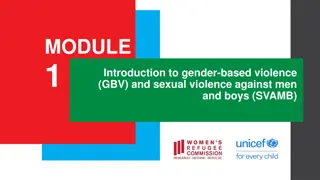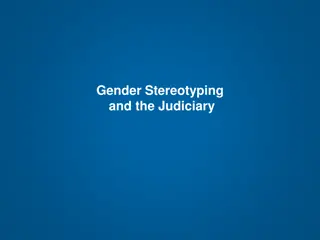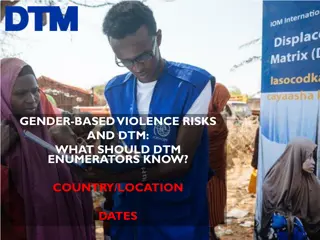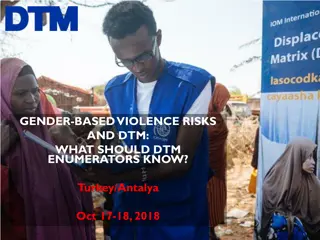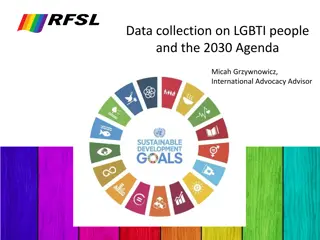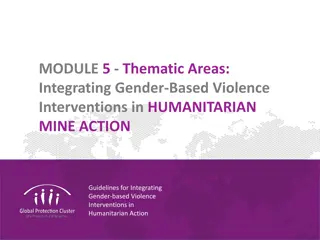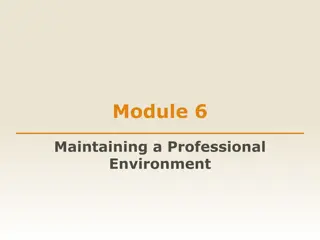Understanding Gender-Based Violence and LGBTI Identities in Interagency Case Management Training
This training module focuses on understanding different terms and definitions related to LGBTI identities, identifying barriers to care for LGBTI survivors, and providing services in a safe and supportive manner. It also discusses the risks of gender-based violence faced by LGBTI-identified individuals and delves into sexual orientation and gender identity terms to enhance awareness and sensitivity.
Download Presentation

Please find below an Image/Link to download the presentation.
The content on the website is provided AS IS for your information and personal use only. It may not be sold, licensed, or shared on other websites without obtaining consent from the author. Download presentation by click this link. If you encounter any issues during the download, it is possible that the publisher has removed the file from their server.
E N D
Presentation Transcript
MODULE 1 INTERAGENCY GENDER-BASED VIOLENCE CASE MANAGEMENT TRAINING
Module 17A GBV CASE MANAGEMENT WITH LGBTI SURVIVORS
Understand different terms and definitions relating to LGBTI identities. OBJECTIVES Identify different barriers to care for LGBTI survivors. Be able to provide services in a safe, understanding, and supportive manner.
LGBTI IDENTIFIED PERSONS AND RISK FOR GBV Already at risk of persecution, discrimination and violence and likely to be specifically targeted due to sexual orientation and /or gender identity Refugee / displacement situations additional hardships, persecution and harm Likely to be isolated and marginalized in displaced settings At risk of sexual violence specifically perpetrated as a hate or bias crime Also intimate partner violence in all of its forms
UNDERSTANDING TERMS: SEXUAL ORIENTATION Sexual orientation Sexual orientation sexual and romantic attractions Heterosexual Heterosexual attracted to people of a different sex Homosexual or gay Homosexual or gay attracted to people of the same sex Gay Gay is usually used for men who are attracted to men. Lesbian Lesbian describes a woman who is attracted to other women. Bisexual Bisexual attracted to both men and women.
UNDERSTANDING TERMS: GENDER IDENTITY Gender identity Gender identity describes whether individual people think of themselves as a man, a woman, or in some cases, another gender Transgender Transgender Transgender people feel their gender identity is not the same as the sex they were assigned at birth Gender queer Gender queer Other people reject thinking of themselves as either man or woman, and may identify themselves as something else, for example gender queer. Androgynous Androgynous A person may present/express their gender as neither male or female, or as a combination of the two Intersex Intersex This is a medical condition in which a person is born with external genitalia or an internal reproductive system that is not considered standard for either males or females. Most intersex people identify as men or women
In small groups, brainstorm some of the challenges faced by LGBTI survivors in seeking services. How can we address these challenges? ACTIVITY: LGBTI SURVIVORS
BARRIERS TO CARE Safety. Safety. fear they will be harmed due to laws against homosexuality, significant homophobia, biphobia, and transphobia Shame and self Shame and self- -blame blame. embarrassment, guilt, self-blame, or vulnerability The person may feel particularly embarrassed if the perpetrator was of the same-sex and overpowered them or successfully used threats or intimidation. Lack of support network. Lack of support network. isolated from family/friends/community In situations of IPV, the abuser may also use threats to out the person as a means of keeping them from seeking help.
BARRIERS TO CARE Fear of not being believed. Fear of not being believed. Many LGBTI people, especially those who experience a sexual-based hate crime, fear they will not be believed Fear of being outed . Fear of being outed . LGBTI survivors may fear that in the process of seeking help, they may be outed meaning that other people will find out their sexual orientation or gender identity, which may result in further stigma, shame or re-victimization. Fear of being blamed. Fear of being blamed. Family, law enforcement, medical and social service providers may blame the survivor s gender identity and/or sexual orientation for what happened.
BARRIERS TO CARE Previous negative experiences. Previous negative experiences. If the person has had negative experiences with first responders and other service providers in the past, they will be unlikely to seek care again. Lack of awareness. Lack of awareness. The lack of visibility for the issues regarding LGBTI sexual violence or partner abuse can result in a lack of awareness, information, education, and resources. Lack of specialized services. Lack of specialized services. In most humanitarian settings, particularly those that are low resource, emergency settings or in countries where being LGBTI is criminalized, it is unlikely that there will be specialized services. This makes it more difficult for survivors to feel that they will be safe and supported when they access care.
PROVIDING CARE AND SUPPORT Deal with your own feelings about LGBTI survivors. Deal with your own feelings about LGBTI survivors. If your own personal beliefs or biases are getting in the way of being non-judgmental of LGBTI survivors, you should probably not be doing direct services with survivors. Do not assume the survivor s gender or sexual orientation. Do not assume the survivor s gender or sexual orientation. As much as possible, take cues from the person and if you are not sure, ask them what resources they think would be best for them.
PROVIDING CARE AND SUPPORT Ask questions in a way that does not assume the gender of the Ask questions in a way that does not assume the gender of the perpetrator. perpetrator. Use language carefully. Use language carefully. Do not ask unnecessary questions. Do not ask unnecessary questions. Your friend. Your wife. Do you have a boyfriend or husband? Are you in a relationship? Gay. Homosexual.
PROVIDING CARE AND SUPPORT Do not out the survivor to other staff, support group members, etc. Do not out the survivor to other staff, support group members, etc. Ask permission before disclosing to another staff person, which you should only need to do if it is clearly relevant for the care and support of the survivor. Reassure the survivor that their reactions are normal Reassure the survivor that their reactions are normal. Let them know that their responses and feelings are okay. Support the survivor. Support the survivor. Let them take the lead; do not press for details if they seem reluctant or unwilling to disclose them.
SAFETY CONSIDERATIONS Be sure you have extensively explored with a survivor their current and past experiences with the police and other authorities as well as safety risks before you and the survivor include them in the safety plan. Due to the stigma involved in identifying as LGBTI, the person may not have a support network and already be isolated. People that identify as LGBTI may be at high risk for suicide, particularly if they have been ostracized from family and community and are isolated.
ACTIVITY: PUTTING IT ALL TOGETHER In small groups discuss either Case Study 1 or Case Study 2 (whichever is assigned to your group). Be prepared to share your discussion with the large group.
CLOSING QUESTIONS? CONCERNS? REFLECTIONS?


